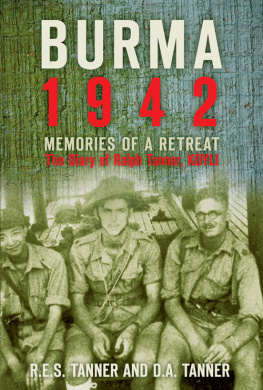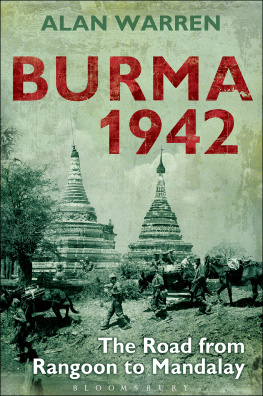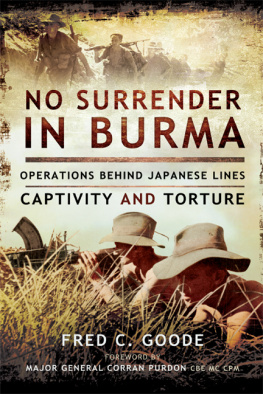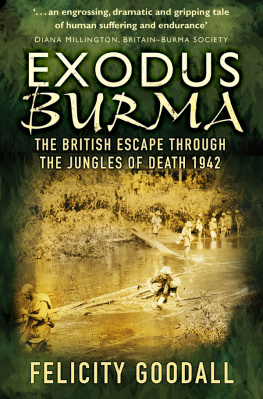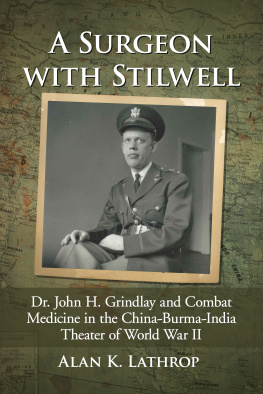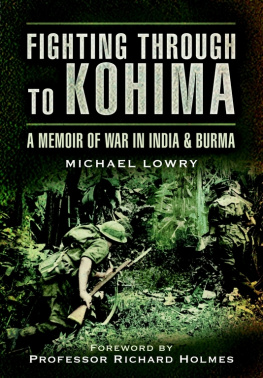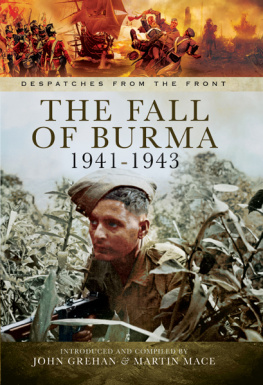
Dedicated to the memory of Corporal James Hart 688, who stayed behind at Bilin on 19th February 1942 to care for a wounded friend, and was never seen again.
The authors wish to express their thanks to the Regimental Museum of the 2nd Battalion The Kings Own Yorkshire Light Infantry at Doncaster for their permission to publish photograph numbers 2, 3, 4, 5, 6, 7, 8, 9, 10 and 11. All other photographs are from the authors private collection or from the History Press archives. Maps shown as Appendix C and C1 are reproduced from the abridged Japanese regimental history of the 214 and 215 Regiments covering the actions in 1942. It has not been possible to locate the copyright holders of this privately published material. The Authors and Publishers would be most grateful for any information and will undertake to credit any parties identified on reprint.
The authors would also like to thank Kazuo Sawa for his research that located the officers of the Japanese 33 Division, Meredith Harte and Todd Londagin for their help in sourcing aircraft photographs, Reiko Fukushima for her help with some of the Japanese translations, and The Royal Geographical Society for the provision of maps to which the authors did not have access. (It is impossible to reproduce old maps with perfect clarity in a book of this size though Ralph Tanners own sketch maps are perfectly understandable but the others reproduced here are artefacts that act in themselves as conduits of memory, at least to those who fought and marched across their pages; for this reason if no other they have been included. Annotations of the movements of KOYLI and other details have been added to them.)
A great debt of thanks is owed to John Heald and the Regimental Museum for Appendix D.
Lastly, thanks are due to Malcolm Johnson, the unofficial historian of the 2nd Battalion The Kings Own Yorkshire Light Infantry for his encouragement and suggestions after reading the first draft of this work.
Contents
The British political and military position in Burma 1941
A military biography of Capt. R.E.S. Tanner. 223473
The availability of war records
The workings of memory
Leaving the dead (and the living) in peace
Training
The battalion as a closed society
Women and children
British equipment
Racism
The Salween at Takaw
The Japanese crossing of the Salween
The Bilin fiasco
The Sittang Bridge disaster
The failure to withdraw at Toksan
The oilfield inferno at Yenangyaung
Taungtha and crossing the Irrawaddy River to Monywa
The cut across country
Japanese behaviour
The misbehaviour of British soldiers
Accidental losses
The process of attrition
Missing in Action?
Malnutrition
Dehydration
Dark thoughts and false optimism
Illness
Lost to the forest
The failure of communications
The civilian population
The re-establishment of the Battalion
The lessons of war
This is a study of a tragedy. It does not seek to accuse but to investigate, and to highlight the extraordinary bravery of those who survived and those who did not. It is an assessment of the work undertaken by the Second Battalion of the Kings Own Yorkshire Light Infantry from the time of their mobilisation in August 1941 until they reached India at the end of May 1942 as an exhausted remainder after 164 days of fighting, disasters and deprivation. It is not simply a personal memoir, although Ralph Tanner, in the second half of the campaign, as a newly commissioned Second Lieutenant, wrote a diary within twelve months after his arrival in India, which forms the basis of this book, together with maps that he kept on his person throughout the retreat, shown in Appendix A. The diary has been supported by maps from other sources and diagrams, along with photographs which he had taken.
Burma 1942 addresses the shortcomings of memory within the context of oral history and the available records. It examines the background to the mobilization of the Battalion in December 1941; who they were and for what they were trained, their equipment and the Battalion as a family with its own spirit. It relates the Battalions series of disasters at Moulmein, Sittang and Bilin involving the crossings of the Salween, Sittang and Bilin rivers, Hmawbwi, Toksan and Yenangyaung which left them increasingly less able to fight as a unit, with diminishing numbers and equipment and finally, the exhausting march from Monywa to the crossing of the Chindwin River and over the last mountains to Tamu on the Indian border and relative safety. The book ends by detailing the factors that prevented optimum military performance and those other factors that made the cohesion of this Battalion from start to finish and individual survival possible.
This work is above all an appreciation of the extraordinary powers of recovery which the men of the Battalion, most of whom were not professional soldiers, showed again and again. The fact that the Battalion survived as a unit after so many days of the gruelling 1942 Burma campaign surely the longest exposure of infantry to warfare in retreat in the history of the British Army is simply remarkable. About a fifth of the men were killed and left with no known grave.
The details of the Battalions involvement have already been published as the fifth volume of the history of the regiment (Kingston,1950) from the recent memories of those who took part. This gave the necessary details of many individual acts of heroism and fortitude and no purpose would be served by repetition, but the citations of two of the three non-commissioned officers who received the Military Medal Howson, Steerment and Butler are given in Appendix B.
Ralph and David Tanner
Padworth Common and London
The British political and military position in Burma 1941
The position of the 2/KOYLI in Burma at the start of the war with Japan in December 1941 is defined by the German war centred on the defence of the United Kingdom. Burma was on the very fringe of British strategic concerns. This can be demonstrated by the fact that the Burma Army headquarters in Rangoon in 1941 was very small and in fact no larger than a normal second class district headquarters in India. It had neither the know-how nor the staff capacities to effect the changes to put Burma onto a war footing (Grant and Tamayama 1999: 39). There were just two British infantry battalions in Burma and a number of military police and Burma Rifle battalions, which had not been trained to confront a professionally trained and organised enemy.
On mobilisation, the 2/KOYLI became part of the 1st Burma Brigade in the 1st Burma Division, which had been created with two other Brigades using the eight Burma Rifle battalions together with the 13th Indian Infantry Brigade of three regular Indian infantry battalions, which arrived in March 1941. This meagre force was added to before Rangoon fell by the creation of the 17th Division with the arrival of the experienced 7th Armoured Brigade (less one regiment) from the Middle East with Stuart tanks better armed than any Japanese tanks and the 63rd Infantry brigade with three further Indian infantry battalions. Following a visit to 17th Division at Kyaiktko on February 6, General Wavell had noted on a train journey from Pegu to the Sittang that the flat, open topography was good tank country. The 7th Armoured was duly despatched, for which everyone who served in Burma in 1942 had cause to be grateful to Wavell (James Lunt, A Hell of a Licking 1986). Additionally, also in March, the Inniskilling Battalion was flown into Magwe in American aircraft. While this total looks impressive enough on paper, their experience of modern warfare with the exception of the 7th Armoured Brigade was limited to internal security and guerrilla warfare on the arid North-West Frontier of India.
Next page
